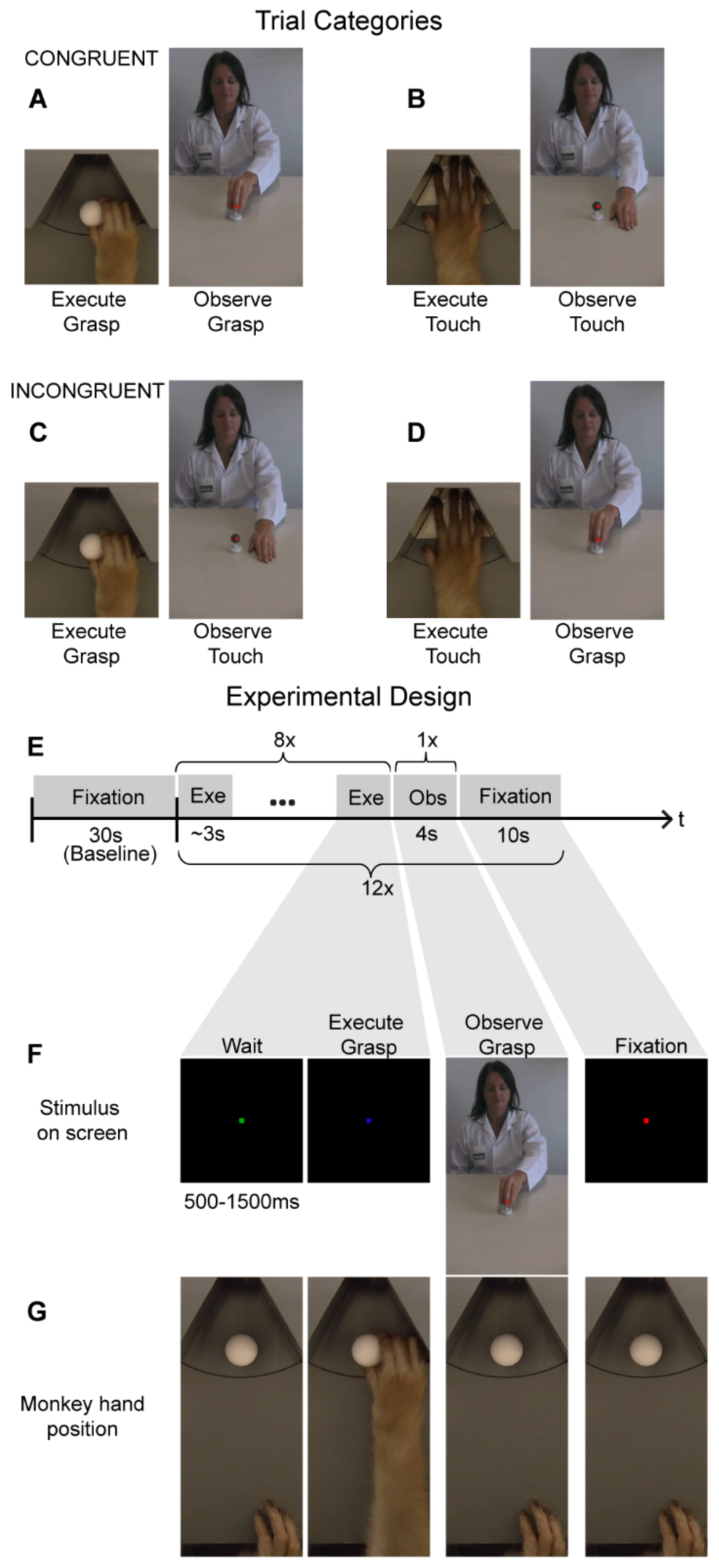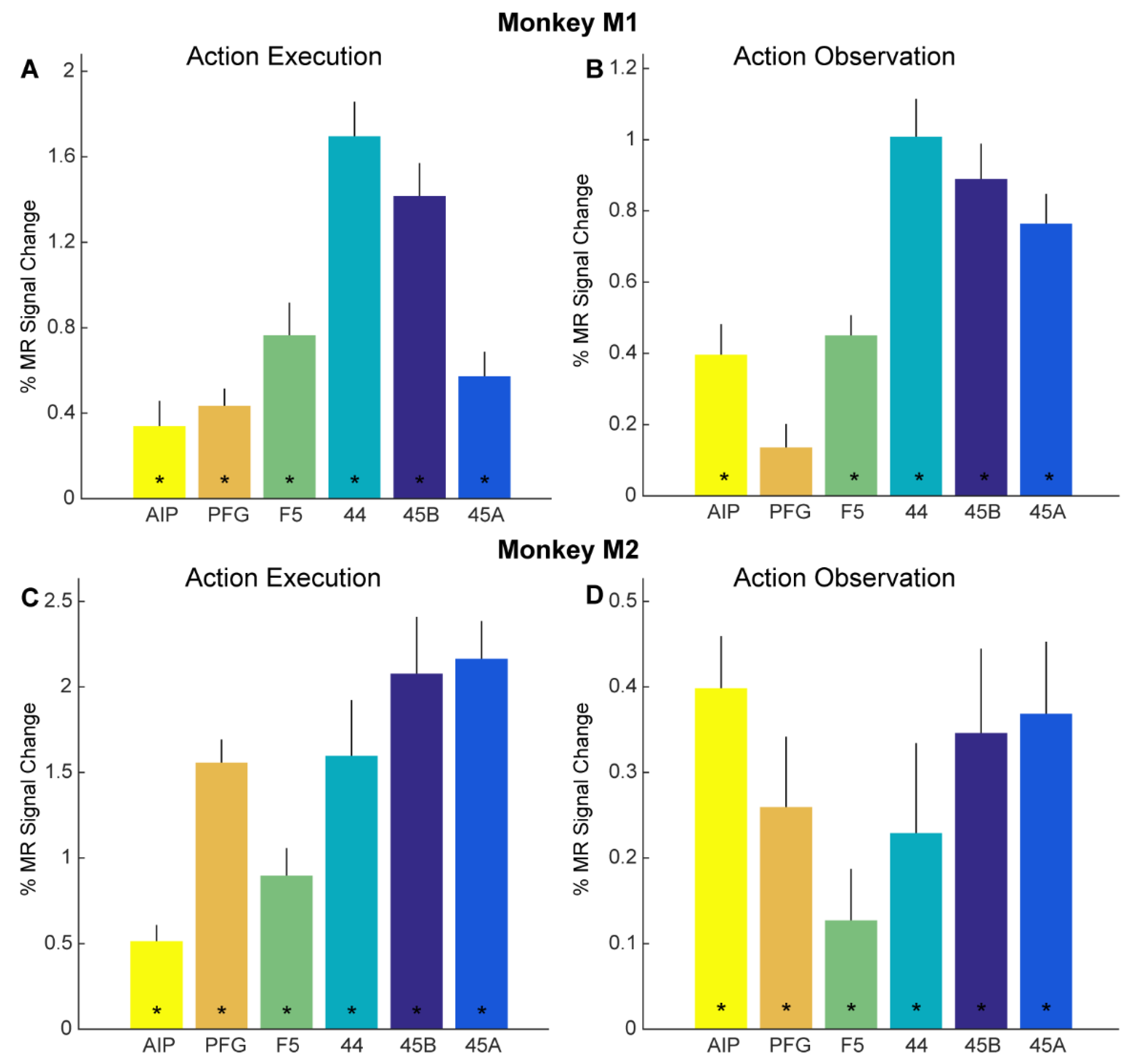No Evidence for Cross-Modal fMRI Adaptation in Macaque Parieto-Premotor Mirror Neuron Regions
Abstract
:1. Introduction
2. Methods
2.1. Subjects
2.2. Fixation Training
2.3. Action Execution Localizer
2.4. Action Observation Localizer
2.5. Cross-Modal fMRI Adaptation
2.6. fMRI Data Acquisition
2.7. Experimental Design
2.8. Data Preprocessing and GLM Fitting
2.9. Univariate Region-of-Interest-Based Analysis
3. Results
3.1. Whole-Brain Investigation of Cross-Modal fMRI Adaptation
3.2. Action Execution and Action Observation fMRI Responses in Regions of Interest
3.3. Cross-Modal fMRI Adaptation in Regions of Interest
4. Discussion
Author Contributions
Funding
Institutional Review Board Statement
Informed Consent Statement
Data Availability Statement
Acknowledgments
Conflicts of Interest
References
- Fiave, P.A.; Sharma, S.; Jastorff, J.; Nelissen, K. Investigating Common Coding of Observed and Executed Actions in the Monkey Brain Using Cross-Modal Multi-Variate FMRI Classification. NeuroImage 2018, 178, 306–317. [Google Scholar] [CrossRef]
- Cui, D.; Nelissen, K. Examining Cross-Modal FMRI Adaptation for Observed and Executed Actions in the Monkey Brain. NeuroImage 2021, 233, 117988. [Google Scholar] [CrossRef] [PubMed]
- Chong, T.T.-J.; Cunnington, R.; Williams, M.A.; Kanwisher, N.; Mattingley, J.B. FMRI Adaptation Reveals Mirror Neurons in Human Inferior Parietal Cortex. Curr. Biol. 2008, 18, 1576–1580. [Google Scholar] [CrossRef] [PubMed]
- de la Rosa, S.; Schillinger, F.L.; Bülthoff, H.H.; Schultz, J.; Uludag, K. FMRI Adaptation between Action Observation and Action Execution Reveals Cortical Areas with Mirror Neuron Properties in Human BA 44/45. Front. Hum. Neurosci. 2016, 10, 78. [Google Scholar] [CrossRef] [PubMed]
- Dinstein, I.; Hasson, U.; Rubin, N.; Heeger, D.J. Brain Areas Selective for Both Observed and Executed Movements. J. Neurophysiol. 2007, 98, 1415–1427. [Google Scholar] [CrossRef] [PubMed]
- Fuelscher, I.; Caeyenberghs, K.; Enticott, P.G.; Kirkovski, M.; Farquharson, S.; Lum, J.; Hyde, C. Does FMRI Repetition Suppression Reveal Mirror Neuron Activity in the Human Brain? Insights from Univariate and Multivariate Analysis. Eur. J. Neurosci. 2019, 50, 2877–2892. [Google Scholar] [CrossRef]
- Kilner, J.; Neal, A.; Weiskopf, N.; Friston, K.J.; Frith, C.D. Evidence of Mirror Neurons in Human Inferior Frontal Gyrus. J. Neurosci. 2009, 29, 10153–10159. [Google Scholar] [CrossRef]
- Lingnau, A.; Gesierich, B.; Caramazza, A. Asymmetric FMRI Adaptation Reveals No Evidence for Mirror Neurons in Humans. Proc. Natl. Acad. Sci. USA 2009, 106, 9925–9930. [Google Scholar] [CrossRef]
- Barron, H.C.; Garvert, M.M.; Behrens TE, J. Repetition Suppression: A Means to Index Neural Representations Using BOLD? Philos. Trans. R. Soc. B Biol. Sci. 2016, 371, 20150355. [Google Scholar] [CrossRef]
- Gotts, S.J.; Chow, C.C.; Martin, A. Repetition Priming and Repetition Suppression: A Case for Enhanced Efficiency through Neural Synchronization. Cogn. Neurosci. 2012, 3, 227–237. [Google Scholar] [CrossRef]
- Krekelberg, B.; Boynton, G.M.; van Wezel, R.J.A. Adaptation: From Single Cells to BOLD Signals. Trends Neurosci. 2006, 29, 250–256. [Google Scholar] [CrossRef]
- Larsson, J.; Smith, A.T. FMRI Repetition Suppression: Neuronal Adaptation or Stimulus Expectation? Cereb. Cortex 2012, 22, 567–576. [Google Scholar] [CrossRef] [PubMed]
- Sawamura, H.; Orban, G.A.; Vogels, R. Selectivity of Neuronal Adaptation Does Not Match Response Selectivity: A Single-Cell Study of the FMRI Adaptation Paradigm. Neuron 2006, 49, 307–318. [Google Scholar] [CrossRef] [PubMed]
- Summerfield, C.; Trittschuh, E.H.; Monti, J.M.; Mesulam, M.-M.; Egner, T. Neural Repetition Suppression Reflects Fulfilled Perceptual Expectations. Nat. Neurosci. 2008, 11, 1004–1006. [Google Scholar] [CrossRef] [PubMed]
- Caggiano, V.; Pomper, J.K.; Fleischer, F.; Fogassi, L.; Giese, M.; Thier, P. Mirror Neurons in Monkey Area F5 Do Not Adapt to the Observation of Repeated Actions. Nat. Commun. 2013, 4, 1433. [Google Scholar] [CrossRef] [PubMed]
- Kilner, J.M.; Kraskov, A.; Lemon, R.N. Do Monkey F5 Mirror Neurons Show Changes in Firing Rate during Repeated Observation of Natural Actions? J. Neurophysiol. 2013, 111, 1214–1226. [Google Scholar] [CrossRef]
- Nelissen, K.; Fiave, P.A.; Vanduffel, W. Decoding Grasping Movements from the Parieto-Frontal Reaching Circuit in the Nonhuman Primate. Cereb. Cortex 2018, 28, 1245–1259. [Google Scholar] [CrossRef]
- Sharma, S.; Fiave, P.A.; Nelissen, K. Functional MRI Responses to Passive, Active, and Observed Touch in Somatosensory and Insular Cortices of the Macaque Monkey. J. Neurosci. 2018, 38, 3689–3707. [Google Scholar] [CrossRef]
- Nelissen, K.; Vanduffel, W. Grasping-Related Functional Magnetic Resonance Imaging Brain Responses in the Macaque Monkey. J. Neurosci. 2011, 31, 8220–8229. [Google Scholar] [CrossRef]
- Vanduffel, W.; Fize, D.; Mandeville, J.B.; Nelissen, K.; Van Hecke, P.; Rosen, B.R.; Tootell, R.B.H.; Orban, G.A. Visual Motion Processing Investigated Using Contrast Agent-Enhanced FMRI in Awake Behaving Monkeys. Neuron 2001, 32, 565–577. [Google Scholar] [CrossRef]
- Friston, K.J.; Holmes, A.P.; Worsley, K.J.; Poline, J.-P.; Frith, C.D.; Frackowiak, R.S.J. Statistical Parametric Maps in Functional Imaging: A General Linear Approach. Hum. Brain Mapp. 1994, 2, 189–210. [Google Scholar] [CrossRef]
- Rouder, J.N.; Speckman, P.L.; Sun, D.; Morey, R.D.; Iverson, G. Bayesiant Tests for Accepting and Rejecting the Null Hypothesis. Psychon. Bull. Rev. 2009, 16, 225–237. [Google Scholar] [CrossRef] [PubMed]
- Durand, J.-B.; Nelissen, K.; Joly, O.; Wardak, C.; Todd, J.T.; Norman, J.F.; Janssen, P.; Vanduffel, W.; Orban, G.A. Anterior Regions of Monkey Parietal Cortex Process Visual 3D Shape. Neuron 2007, 55, 493–505. [Google Scholar] [CrossRef] [PubMed]
- Murata, A.; Gallese, V.; Luppino, G.; Kaseda, M.; Sakata, H. Selectivity for the Shape, Size, and Orientation of Objects for Grasping in Neurons of Monkey Parietal Area AIP. J. Neurophysiol. 2000, 83, 2580–2601. [Google Scholar] [CrossRef]
- Gregoriou, G.G.; Borra, E.; Matelli, M.; Luppino, G. Architectonic Organization of the Inferior Parietal Convexity of the Macaque Monkey. J. Comp. Neurol. 2006, 496, 422–451. [Google Scholar] [CrossRef]
- Rozzi, S.; Ferrari, P.F.; Bonini, L.; Rizzolatti, G.; Fogassi, L. Functional Organization of Inferior Parietal Lobule Convexity in the Macaque Monkey: Electrophysiological Characterization of Motor, Sensory and Mirror Responses and Their Correlation with Cytoarchitectonic Areas. Eur. J. Neurosci. 2008, 28, 1569–1588. [Google Scholar] [CrossRef]
- Belmalih, A.; Borra, E.; Contini, M.; Gerbella, M.; Rozzi, S.; Luppino, G. Multimodal Architectonic Subdivision of the Rostral Part (Area F5) of the Macaque Ventral Premotor Cortex. J. Comp. Neurol. 2009, 512, 183–217. [Google Scholar] [CrossRef]
- Gerbella, M.; Belmalih, A.; Borra, E.; Rozzi, S.; Luppino, G. Cortical Connections of the Anterior (F5a) Subdivision of the Macaque Ventral Premotor Area F5. Brain Struct. Funct. 2001, 216, 43–65. [Google Scholar] [CrossRef]
- Nelissen, K.; Luppino, G.; Vanduffel, W.; Rizzolatti, G.; Orban, G.A. Observing Others: Multiple Action Representation in the Frontal Lobe. Science 2005, 310, 332–336. [Google Scholar] [CrossRef]
- di Pellegrino, G.; Fadiga, L.; Fogassi, L.; Gallese, V.; Rizzolatti, G. Understanding Motor Events: A Neurophysiological Study. Exp. Brain Res. 1992, 91, 176–180. [Google Scholar] [CrossRef]
- Fogassi, L. Parietal Lobe: From Action Organization to Intention Understanding. Science 2005, 308, 662–667. [Google Scholar] [CrossRef]
- Gallese, V.; Fadiga, L.; Fogassi, L.; Rizzolatti, G. Action Recognition in the Premotor Cortex. Brain A J. Neurol. 1996, 119 Pt 2, 593–609. [Google Scholar] [CrossRef] [PubMed]
- Romero, M.C.; Pani, P.; Janssen, P. Coding of Shape Features in the Macaque Anterior Intraparietal Area. J. Neurosci. 2014, 34, 4006–4021. [Google Scholar] [CrossRef]
- Theys, T.; Srivastava, S.; van Loon, J.; Goffin, J.; Janssen, P. Selectivity for Three-Dimensional Contours and Surfaces in the Anterior Intraparietal Area. J. Neurophysiol. 2012, 107, 995–1008. [Google Scholar] [CrossRef]
- Sharma, S.; Mantini, D.; Vanduffel, W.; Nelissen, K. Functional Specialization of Macaque Premotor F5 Subfields with Respect to Hand and Mouth Movements: A Comparison of Task and Resting-State FMRI. NeuroImage 2019, 191, 441–456. [Google Scholar] [CrossRef] [PubMed]
- Petrides, M.; Cadoret, G.; Mackey, S. Orofacial Somatomotor Responses in the Macaque Monkey Homologue of Broca’s Area. Nature 2005, 435, 1235–1238. [Google Scholar] [CrossRef] [PubMed]
- Gerbella, M.; Belmalih, A.; Borra, E.; Rozzi, S.; Luppino, G. Multimodal Architectonic Subdivision of the Caudal Ventrolateral Prefrontal Cortex of the Macaque Monkey. Brain Struct. Funct. 2007, 212, 269–301. [Google Scholar] [CrossRef] [PubMed]
- Petrides, M.; Pandya, D.N. Dorsolateral Prefrontal Cortex: Comparative Cytoarchitectonic Analysis in the Human and the Macaque Brain and Corticocortical Connection Patterns. Eur. J. Neurosci. 1999, 11, 1011–1036. [Google Scholar] [CrossRef] [PubMed]
- Petrides, M.; Pandya, D.N. Comparative Cytoarchitectonic Analysis of the Human and the Macaque Ventrolateral Prefrontal Cortex and Corticocortical Connection Patterns in the Monkey. Eur. J. Neurosci. 2002, 16, 291–310. [Google Scholar] [CrossRef]
- Saleem, K.S.; Miller, B.; Price, J.L. Subdivisions and Connectional Networks of the Lateral Prefrontal Cortex in the Macaque Monkey. J. Comp. Neurol. 2014, 522, 1641–1690. [Google Scholar] [CrossRef]
- Press, C.; Catmur, C.; Cook, R.; Widmann, H.; Heyes, C.; Bird, G. FMRI Evidence of ‘Mirror’ Responses to Geometric Shapes. PLoS ONE 2012, 7, e51934. [Google Scholar] [CrossRef] [PubMed]
- Oosterhof, N.N.; Tipper, S.P.; Downing, P.E. Crossmodal and Action-Specific: Neuroimaging the Human Mirror Neuron System. Trends Cogn. Sci. 2013, 17, 311–318. [Google Scholar] [CrossRef] [PubMed]
- Rizzolatti, G.; Sinigaglia, C. The Mirror Mechanism: A Basic Principle of Brain Function. Nat. Rev. Neurosci. 2016, 17, 757–765. [Google Scholar] [CrossRef] [PubMed]
- Nelissen, K.; Borra, E.; Gerbella, M.; Rozzi, S.; Luppino, G.; Vanduffel, W.; Rizzolatti, G.; Orban, G.A. Action Observation Circuits in the Macaque Monkey Cortex. J. Neurosci. 2011, 31, 3743–3756. [Google Scholar] [CrossRef]
- Grigaityte, K.; Iacoboni, M. How to Study the Mirror Neuron System with Functional MRI: Challenges and Solutions. In New Frontiers in Mirror Neurons Research; Oxford University Press: Oxford, UK, 2015; pp. 72–88. [Google Scholar] [CrossRef]




| Monkey M1 | Monkey M2 | |||
|---|---|---|---|---|
| Anatomical | Intersected | Anatomical | Intersected | |
| AIP | 113 | 13 | 102 | 28 |
| PFG | 108 | 17 | 90 | 34 |
| F5 | 409 | 176 | 415 | 79 |
| 44 | 49 | 27 | 50 | 19 |
| 45b | 107 | 80 | 98 | 60 |
| 45a | 79 | 49 | 63 | 47 |
Disclaimer/Publisher’s Note: The statements, opinions and data contained in all publications are solely those of the individual author(s) and contributor(s) and not of MDPI and/or the editor(s). MDPI and/or the editor(s) disclaim responsibility for any injury to people or property resulting from any ideas, methods, instructions or products referred to in the content. |
© 2023 by the authors. Licensee MDPI, Basel, Switzerland. This article is an open access article distributed under the terms and conditions of the Creative Commons Attribution (CC BY) license (https://creativecommons.org/licenses/by/4.0/).
Share and Cite
Sharma, S.; Nelissen, K. No Evidence for Cross-Modal fMRI Adaptation in Macaque Parieto-Premotor Mirror Neuron Regions. Brain Sci. 2023, 13, 1466. https://doi.org/10.3390/brainsci13101466
Sharma S, Nelissen K. No Evidence for Cross-Modal fMRI Adaptation in Macaque Parieto-Premotor Mirror Neuron Regions. Brain Sciences. 2023; 13(10):1466. https://doi.org/10.3390/brainsci13101466
Chicago/Turabian StyleSharma, Saloni, and Koen Nelissen. 2023. "No Evidence for Cross-Modal fMRI Adaptation in Macaque Parieto-Premotor Mirror Neuron Regions" Brain Sciences 13, no. 10: 1466. https://doi.org/10.3390/brainsci13101466
APA StyleSharma, S., & Nelissen, K. (2023). No Evidence for Cross-Modal fMRI Adaptation in Macaque Parieto-Premotor Mirror Neuron Regions. Brain Sciences, 13(10), 1466. https://doi.org/10.3390/brainsci13101466






